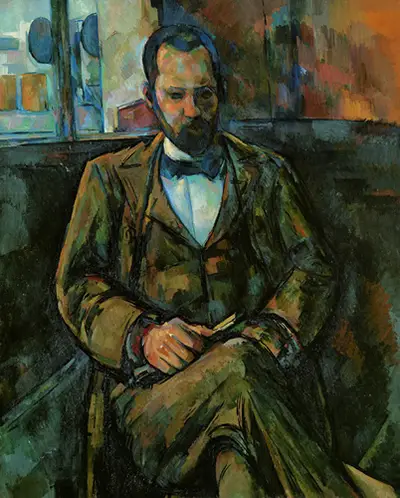Portrait of Ambroise Vollard by Paul Cezanne was created in 1899, and is an oil on canvas portrait from the post-impressionism period, with the dimensions 100 x 81 cm. The painting is housed at Paris's Petit Palais in France.
Ambroise Vollard was an art dealer who sold and exhibited paintings for Paul Cezanne. The story is that Cezanne made Vollard sit still for the portrait for weeks, losing him work and making him very tense, as the painting is supposed to portray, and then walked away without declaring the work finished. Whether this was a joke or the settling of a score is unknown. The painting is a seated portrait with tension and darkness, almost full length but missing the lower legs and feet. The subject is dressed in a dark suit that almost blends him in with the dark background of his seat and the brown behind him.
The subject's face is gloomy, solemn and serious, bordering on impatient or annoyed, but his face is shadowed in the dark background, especially his eyes and mouth, making the strength of his expression hard to read. The subject has a long slim and slightly pointed face, with short smooth hair going straight into his beard, he has a moustache. His eyes look to be brown, but in the shadow it is hard to tell. His ears are prominent against short hair, and he has a slight hook to his nose. His skin isn't pale, possibly darkish, but the shadows make it hard to tell.
The subject is dressed in a brown suit,with a white shirt and black bow tie. The seat around him is black or dark brown, meaning that his brown suit merges with the darkness of the seat. He has his legs crossed and his hands on his lap, in his hands are what looks to be some papers or notes. The subject is looking straight ahead but not directly at the artist. The dark colours of the painting are striking as they take up a majority of the painting, the brown wall behind the subject, the dark seat that he sits in, the dark brown suit that he wears, and the way his head is shadowed by the darkness around him.
There is one bit of light in the painting, which may take some focus, and that is what appears to be a small window to the left of the subject's head as you look at him, the window gives a small amount of grey light, and shows a glimpse of house roofs and chimneys outside. It is something to wonder about, why the artist chose this light and background in which to create a portrait.




